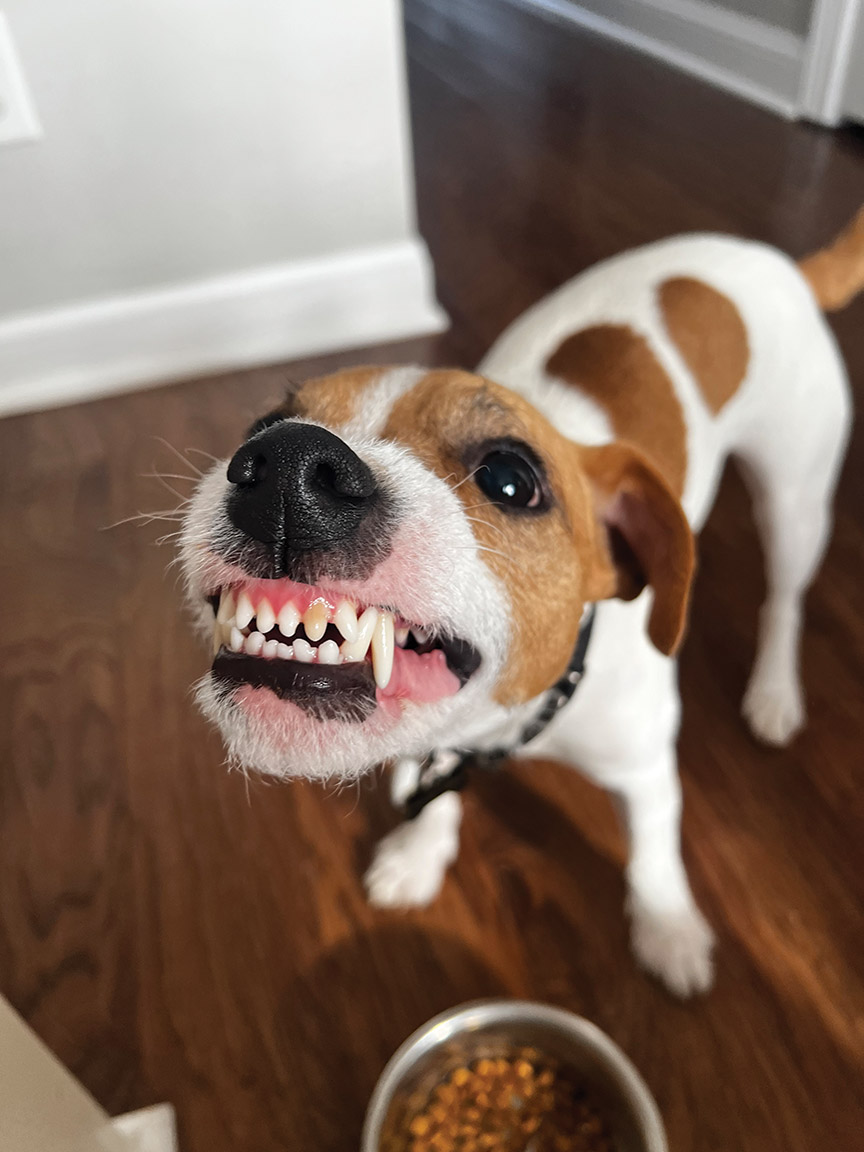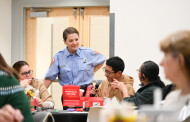February is National Dental Health month for all our canine and feline friends out there. This is a time for us to take a look inside their mouths during our daily cuddle sessions. It is estimated that 70-80% of all cats and dogs that are two years and older suffer from preventable dental diseases like gingivitis and periodontitis.
Periodontal disease is a progressive disorder affecting the teeth and gums, which is caused by a build-up of plaque and tartar on the tooth surface. The largest contributing factor to plaque development is the entrapment of food debris in the mouth. Feeding your pet dry food can help clean the teeth, but that alone is not enough to protect against dental disease. Without adequate care and attention, periodontal disease can result in discomfort, bad breath, irreversible damage to gums, premature loss of teeth, and infections that can affect other organs in the body such as the heart, liver and kidneys.
There are so many ways to take care of our pets’ teeth, but it can be broken down into three main categories: brushing, treats, and toys!
Brushing
Tooth brushing can either be a nightmare or it can be the absolute best thing you can do for your pet’s oral health. We take for granted that brushing our teeth is an easy thing to do, but our pets have no idea how it is supposed to work! We recommend starting with the easy part – licking toothpaste! Fortunately, pet toothpaste is flavored to taste like poultry, beef, or seafood and is easily digestible, so swallowing is encouraged.
Start out with small amounts just on your fingertips to make it seem like a treat. Practice this for however long it takes your pet to feel comfortable; puppies, cats, and older dogs can sometimes take several weeks at this step whereas more amenable dogs can do this for a short time.
The next step is introducing the toothbrush, but not in their mouth. Apply the toothpaste to the toothbrush and allow your pet to lick the toothpaste off of it. All we are doing here is replacing your finger with the brush. Again, stay on this step until your pet is comfortable with the toothbrush. This can take some time as this is a strange object.
Finally, we move to brushing. Getting your pet comfortable with the toothbrush in their mouth is a challenge, so you should be in the best place possible for it. Focus the bristles of the brush on the outer surface of the teeth. Do not try to brush the inside of their mouth. Cats and dogs can flinch easily and having the toothbrush inside their mouth when this happens can cause an injury or discomfort. It is also important to note that any amount helps. If you only get to brush for 10 seconds, that’s better than nothing. Stay persistent and keep it up!
Treats
There are so many different treats out there that claim to help with your pet’s oral health, but not all of them can make the short list verified and recommended by the Veterinary Oral Health Council (VOHC). This council is composed of veterinary dentists that work hard to provide the best quality of care for all animals’ dental and oral health. Two products that are suitable for almost any pet out there are listed below. They pair well with hypoallergenic diets as well as picky eaters.
CET Veggie Chews are designed to perform on the teeth with a texture and shape that mimic that of brushing. This action can only be efficient and effective when chewed and eaten slowly and not swallowed instantly. The enzymes in the treats also help prevent tartar build-up. These chews are most effective when given after a meal and only once per day.
Perio Support Powder is a powder that can be applied over the food. Small amounts are sprinkled on and mixed in with a normal diet for every meal. The powder works by penetrating existing plaque and supporting gum health, which in turn helps to maintain clean teeth and fresh breath. The powder will be activated once in the mouth and will then become sticky and adhere to the teeth. It will form a barrier on the teeth for several hours after a meal. It has no flavoring to it, so it should not be something dogs detect.
Toys
When it comes to the toys your dog plays with, choosing wisely can help avoid a big bill. Remember that there is no perfect chew toy for your pet. Supervision should be provided whenever your pet is given chew toys, especially those that they are able to tear into smaller pieces. A good rule to follow is that your dog should never chew on anything harder than its teeth. We are able to determine this through a simple test. Using your fingernail, attempt to make an indentation in the chewing surface of the toy. Nylon bones, natural bones, pig ears, cow hooves and ice cubes are too hard to create this indentation and may lead to fractured teeth. Kong toys are firm rubber toys that are compressible and provide good chewing activity for your dog while saving their teeth from breaking.
My favorite hack for the rubber toys that have a hollow center (like the original red Kong toy) is to spread peanut butter or cream cheese along the inside and put it in the freezer for several hours. Once you pull it out, it will be a cool treat that will take hours to devour!
These same rules apply to cats as well! They have wonderful bell balls that they will chase around for hours but keep a close eye and make sure that they do not start chewing on them, or it could lead to tooth fracture.
All of these things can help individually, but together they can work wonders for our dogs and cats and their overall health.
Melissa Reel is a surgery technician at Lake Pine Animal Hospital. Melissa graduated with an animal science degree in 2018 B.S., B.A., M.S. She is currently making arrangements to attend vet school.








